Impacts of Transition Approach of Water Vapor-Related Microphysical Processes on Quantitative Precipitation Forecasting
Abstract
:1. Introduction
2. Scheme Description
2.1. The Cloud Microphysics Scheme
2.2. Descriptions of the SUTA and the PSTA
3. Model and Dataset
3.1. CMA_MESO Model
3.2. Experiment Setup
3.3. Gauge Precipitation
4. Results
4.1. Analysis of Rainfall Event
4.1.1. Precipitation
4.1.2. Source and Sink Terms of WVRMPs
4.1.3. Hydrometeor Contents
4.2. Assessment of Batch Experiments
4.2.1. Average Precipitation Amount
4.2.2. Equitable Threat Score of Precipitation
5. Conclusions and Discussion
Author Contributions
Funding
Institutional Review Board Statement
Informed Consent Statement
Data Availability Statement
Acknowledgments
Conflicts of Interest
Appendix A. The Formulations of Water Vapor-Related Microphysical Processes
- a.
- Condensation and evaporation of cloud droplets (SVC)
- b.
- Evaporation of raindrops (SVR)
- a.
- Ice initial nucleation (PVI)
- b.
- Deposition and Sublimation of cloud crystals (SVI) and snow (SVS)
- c.
- Deposition and Sublimation of graupel (SVG)
References
- Yu, R.C.; Zhang, Y.; Wang, J.J.; Li, J.; Chen, H.M.; Gong, J.D.; Chen, J. Recent Progress in Numerical Atmospheric Modeling in China. Adv. Atmos. Sci. 2019, 36, 938–960. [Google Scholar] [CrossRef]
- Barszcz, A.; Milbrandt, J.A.; Thériault, J.M. Improving the Explicit Prediction of Freezing Rain in a Kilometer-Scale Numerical Weather Prediction Model. Wea. Forecast. 2018, 33, 767–782. [Google Scholar] [CrossRef]
- Klein, S.A.; Jakob, C. Validation and Sensitivities of Frontal Clouds Simulated by the ECMWF Model. Mon. Weather Rev. 1999, 127, 2514–2531. [Google Scholar] [CrossRef]
- Wang, Y.; Fan, J.; Zhang, R.; Leung, L.R.; Franklin, C. Improving bulk microphysics parameterizations in simulations of aerosol effects. J. Geophys. Res. Atmos. 2013, 118, 5361–5379. [Google Scholar] [CrossRef]
- Milbrandt, J.A.; Morrison, H. Parameterization of Cloud Microphysics Based on the Prediction of Bulk Ice Particles Properties. Part III: Introduction of Multiple Free Categories. J. Atmos. Sci. 2016, 73, 975–995. [Google Scholar] [CrossRef]
- Thompson, G.; Eidhammer, T. A Study of Aerosol Impacts on Clouds and Precipitation Development in a Large Winter Cyclone. J. Atmos. Sci. 2014, 71, 3636–3658. [Google Scholar] [CrossRef]
- Morrison, H.; Thompson, G.; Tatarskii, V. Impact of cloud microphysics on the development of trailing stratiform precipitation in a simulated squall line: Comparison of one- and two-moment schemes. Mon. Weather Rev. 2009, 137, 991–1007. [Google Scholar] [CrossRef] [Green Version]
- Hong, S.-Y.; Dudhia, J.; Chen, S.-H. A Revised Approach to Ice Microphysical Processes for the Bulk Parameterization of Clouds and Precipitation. Mon. Weather Rev. 2004, 132, 103–120. [Google Scholar] [CrossRef]
- Khain, A.P.; Rosenfeld, D.; Pokrovsky, A. Aerosol impact on the dynamics and microphysics of deep convective clouds. Quart. J. R. Meteor. Soc. 2005, 131, 2639–2663. [Google Scholar] [CrossRef] [Green Version]
- Flossmann, A.I.; Wobrock, W. A review of our understanding of the aerosol—Cloud interaction from the perspective of a bin resolved cloud scale modelling. Atmos. Res. 2010, 97, 478–497. [Google Scholar] [CrossRef]
- Vié, B.; Pinty, J.P.; Berthet, S.; Leriche, M. LIMA (v1.0): A quasi two-moment microphysical scheme driven by a multimodal population of cloud condensation and ice freezing nuclei. Geosci. Model Dev. 2016, 9, 567–586. [Google Scholar] [CrossRef] [Green Version]
- Morrison, H.; Grabowski, W.W. A Novel Approach for Representing Ice Microphysics in Models: Description and Tests Using a Kinematic Framework. J. Atmos. Sci. 2008, 65, 1528–1548. [Google Scholar] [CrossRef] [Green Version]
- Ma, Z.; Milbrandt, J.A.; Liu, Q.; Zhao, C.; Li, Z.; Tao, F.; Sun, J.; Shen, X.; Kong, Q.; Zhou, F.; et al. Sensitivity of snowfall forecast over North China to ice crystal deposition/sublimation parameterizations in the WSM6 cloud microphysics scheme. Quart. J. R. Meteor. Soc. 2021, 147, 3349–3372. [Google Scholar] [CrossRef]
- Harrington, J.Y.; Meyers, M.P.; Walko, R.L.; Cotton, W.R. Parameterization of Ice Crystal Conversion Processes Due to Vapor Deposition for Mesoscale Models Using Double-Moment Basis Functions. Part I: Basic Formulation and Parcel Model Results. J. Atmos. Sci. 1995, 52, 4344–4366. [Google Scholar] [CrossRef] [Green Version]
- Koenig, L.R. Parameterization of Ice Growth for Numerical Calculations of Cloud Dynamics. Mon. Weather Rev. 1972, 100, 417–423. [Google Scholar] [CrossRef]
- Lim, K.-S.S.; Hong, S.-Y. Development of an Effective Double-Moment Cloud Microphysics Scheme with Prognostic Cloud Condensation Nuclei (CCN) for Weather and Climate Models. Mon. Weather Rev. 2010, 138, 1587–1612. [Google Scholar] [CrossRef] [Green Version]
- Ma, Z.; Liu, Q.; Sun, J.; Kong, Q.; Li, Z.; Shen, X.; Zhao, C.; Dai, K.; Tao, F. Study on the reason for overestimation of a snowfall case by WSM6 cloud microphysical scheme over North China. Meteor. Mon. 2021, 47, 1029–1046. (In Chinese) [Google Scholar]
- Hu, Z.; Yan, C. Numerical Simulation of Microphysical Processes in Stratiform Clouds (I)—Microphysical Model. J. Acad. Meteorol. Sci. S.M.A. China 1986, 1, 37–52. (In Chinese) [Google Scholar]
- Hu, Z.; Yan, C. Numerical Simulation of Microphysical Processes in Stratiform Clouds (II)—Microphysical Processes in Middle-Latitude Cyclone Cloud Systems. J. Acad. Meteorol. Sci. 1987, 2, 133–142. (In Chinese) [Google Scholar]
- Hu, Z.; He, G. Numerical Simulation of Microphysical Processes in Cumulonimbus—Part I: Microphysical Model. Acta Meteor. Sin. 1988, 2, 471–489. [Google Scholar]
- Hu, Z.; He, G. Numerical Simulation of Microphysical Processes in Cumulonimbus—Part II: Case Studies of Shower, Hailstorm and Torrential Rain. Acta Meteor. Sin. 1989, 3, 185–199. [Google Scholar]
- Liu, Q.; Hu, Z.; Zhou, X. Explicit Cloud Schemes of HLAFS and Simulation of Heavy Rainfall and Clouds, Part I: Explicit Cloud Schemes. J. Appl. Meteor. Sci. 2003, 14, 60–67. (In Chinese) [Google Scholar]
- Liu, Q.; Hu, Z.; Zhou, X. Explicit Cloud Schemes of HLAFS And Simulation of Heavy Rainfall And Clouds, Part II: Simulation of Heavy Rainfall and Clouds. J. Appl. Meteor. Sci. 2003, 14, 68–77. (In Chinese) [Google Scholar]
- Hua, C.; Liu, Q. Numerical simulation of cloud microphysical characteristics of landfall typhoon KROSA. J. Trop. Meteor. 2013, 19, 284–296. [Google Scholar]
- Nie, H.; Liu, Q.; Ma, Z. Simulation and Analysis of Heavy Precipitation Using Cloud Microphysical Scheme Coupled with High-Resolution GRAPES Model. Meteor. Mon. 2016, 42, 1431–1444. (In Chinese) [Google Scholar]
- Li, Z.; Zhang, Y.; Liu, Q.; Fu, S.; Ma, Z. A Study of the Influence of Microphysical Processes on Typhoon Nida (2016) using a New Double-Moment Microphysics Scheme in the Weather Research and Forecasting Model. J. Trop. Meteor. 2018, 24, 123–130. [Google Scholar]
- Chen, X.; Liu, Q.; Zhang, J. A Numerical Simulation Study On Microphysical Structure And Cloud Seeding In Cloud System of Qilian Mountain Region. Meteor. Mon. 2007, 33, 33–43. (In Chinese) [Google Scholar]
- Liu, W.; Liu, Q. The Numerical Simulation of Orographic Cloud Structure and Cloud Microphysical Processes in Qilian Mountains in Summer. Part (I): Cloud Microphysical Scheme and Orographic Cloud Structure. Plateau Meteor. 2007, 26, 1–15. (In Chinese) [Google Scholar]
- Shen, X.; Su, Y.; Hu, J.; Wang, J.; Sun, J.; Xue, J.; Han, W.; Zhang, H.; Lu, H.; Zhang, H.; et al. Development and operation transformation of GRAPES global middle-range forecast system. J. Appl. Meteor. Sci. 2017, 28, 1–10. (In Chinese) [Google Scholar]
- Huang, L.; Chen, D.; Deng, L.; Xu, Z.; Yu, F.; Jiang, Y.; Zhou, F. Main Technical Improvements of GRAPES_Meso V4.0 and Verification. J. Appl. Meteor. Sci. 2017, 28, 25–37. (In Chinese) [Google Scholar]
- Ma, S.; Zhang, J.; Shen, X.; Wang, Y. The Upgrads of GRAPES_TYM in 2016 and Its Impacts on Tropical Cyclone Prediction. J. Appl. Meteor. Sci. 2018, 29, 257–269. (In Chinese) [Google Scholar]
- Ma, Z.; Liu, Q.; Zhao, C.; Shen, X.; Wang, Y.; Jiang, J.H.; Li, Z.; Yung, Y. Application and Evaluation of an Explicit Prognostic Cloud-Cover Scheme in GRAPES Global Forecast System. J. Adv. Model. Earth Syst. 2018, 10, 652–667. [Google Scholar] [CrossRef]
- Ma, Z.; Zhao, C.; Gong, J.; Zhang, J.; Li, Z.; Sun, J.; Liu, Y.; Chen, J.; Jiang, Q. Spin-up characteristics with three types of initial fields and the restart effects on forecast accuracy in the GRAPES global forecast system. Geosci. Model Dev. 2021, 14, 205–221. [Google Scholar] [CrossRef]
- Mlawer, E.J.; Taubman, S.J.; Brown, P.D.; Iacono, M.J.; Clough, S.A. Radiative Transfer for Inhomogeneous Atmospheres: RRTM, a Validated Correlated-K Model for the Longwave. J. Geophys. Res. Atmos. 1997, 102, 16663–16682. [Google Scholar] [CrossRef] [Green Version]
- Dudhia, J. A nonhydrostatic version of the Penn State-NCAR mesoscale model: Validation tests and simulation of an Atlantic cyclone and cold front. Mon. Weather Rev. 1993, 121, 1493–1513. [Google Scholar] [CrossRef] [Green Version]
- Chen, F.; Dudhia, J. Coupling an advanced land surface-hydrology model with the Penn State-NCAR MM5 modeling system. Part I: Model implementation and sensitivity. Mon. Weather Rev. 2001, 129, 569–585. [Google Scholar] [CrossRef] [Green Version]
- Hong, S.-Y.; Pan, H.-L. Nonlocal boundary layer vertical diffusion in a medium-range forecast model. Mon. Weather Rev. 1996, 124, 2322–2339. [Google Scholar] [CrossRef] [Green Version]
- Su, Y.; Zhao, C.; Wang, Y.; Ma, Z. Spatiotemporal Variations of Precipitation in China Using Surface Gauge Observations from 1961 to 2016. Atmosphere 2020, 11, 303. [Google Scholar] [CrossRef] [Green Version]
- Hamill, T.M. Hypothesis Tests for Evaluating Numerical Precipitation Forecasts. Weather Forecast. 1999, 14, 155–167. [Google Scholar] [CrossRef]
- Rutledge, S.A.; Hobbs, P.V. The mesoscale and Microsccale Structure and Organization of Clouds and Precipitation in Midlatitude Cyclones. VIII: A Model for the “Seed-Feeder” Process in Warm-Frontal Rainbans. J. Atmos. Sci. 1983, 46, 1185–1206. [Google Scholar] [CrossRef] [Green Version]
- Reisner, J.; Rasmussen, R.M.; Bruintjes, R.T. Explicit forecasting of supercooled liquid water in winter storms using the MM5 mesoscale model. Quart. J. Roy. Meteor. Soc. 1998, 124, 1071–1107. [Google Scholar] [CrossRef]
- Pérez, R.; Lopes, V.L.R. Recent applications and numerical implementation of quasi-Newton methods for solving nonlinear systems of equations. Numer. Algorithms 2004, 35, 261–285. [Google Scholar] [CrossRef]
- Esentürk, E.; Abraham, N.L.; Archer-Nicholls, S.; Mitsakou, C.; Griffiths, P.; Archibald, A.; Pyle, J. Quasi-Newton methods for atmospheric chemistry simulations: Implementation in UKCA UM vn10.8. Geosci. Model Dev. 2018, 11, 3089–3108. [Google Scholar] [CrossRef] [Green Version]
- Byers, H.R. Elements of Cloud Physics; The University of Chicago Press: Chicago, IL, USA, 1965; p. 191. [Google Scholar]
- Orville, H.D.; Kopp, F.J. Numerical simulation of the history of a hailstorm. J. Atmos. Sci. 1997, 34, 1596–1618. [Google Scholar] [CrossRef] [Green Version]
- Fletcher, N.H. The Physics of Rain Clouds; Cambridge University Press: Cambridge, UK, 1962. [Google Scholar]
- Cotton, W.R.; Tripoli, G.J.; Rauber, R.M.; Mulvihill, E.A. Numerical simulation of the effects of varyin gice crystal nucleation rates and aggregation processes on orographic snowfall. J. Climate App. Meteor. 1986, 25, 1658–1680. [Google Scholar] [CrossRef] [Green Version]
- Huffman, P.J. Supersaturation spectra of AgI and Natural ice nuclei. J. Appl. Meteor. 1973, 12, 1080–1087. [Google Scholar] [CrossRef]
- Meyers, M.P.; Demott, P.J.; Cotton, W.R. New Primary Ice-Nucleation Parameterizations in an Explicit Cloud Model. J. Appl. Meteor. 1992, 31, 708–721. [Google Scholar] [CrossRef] [Green Version]
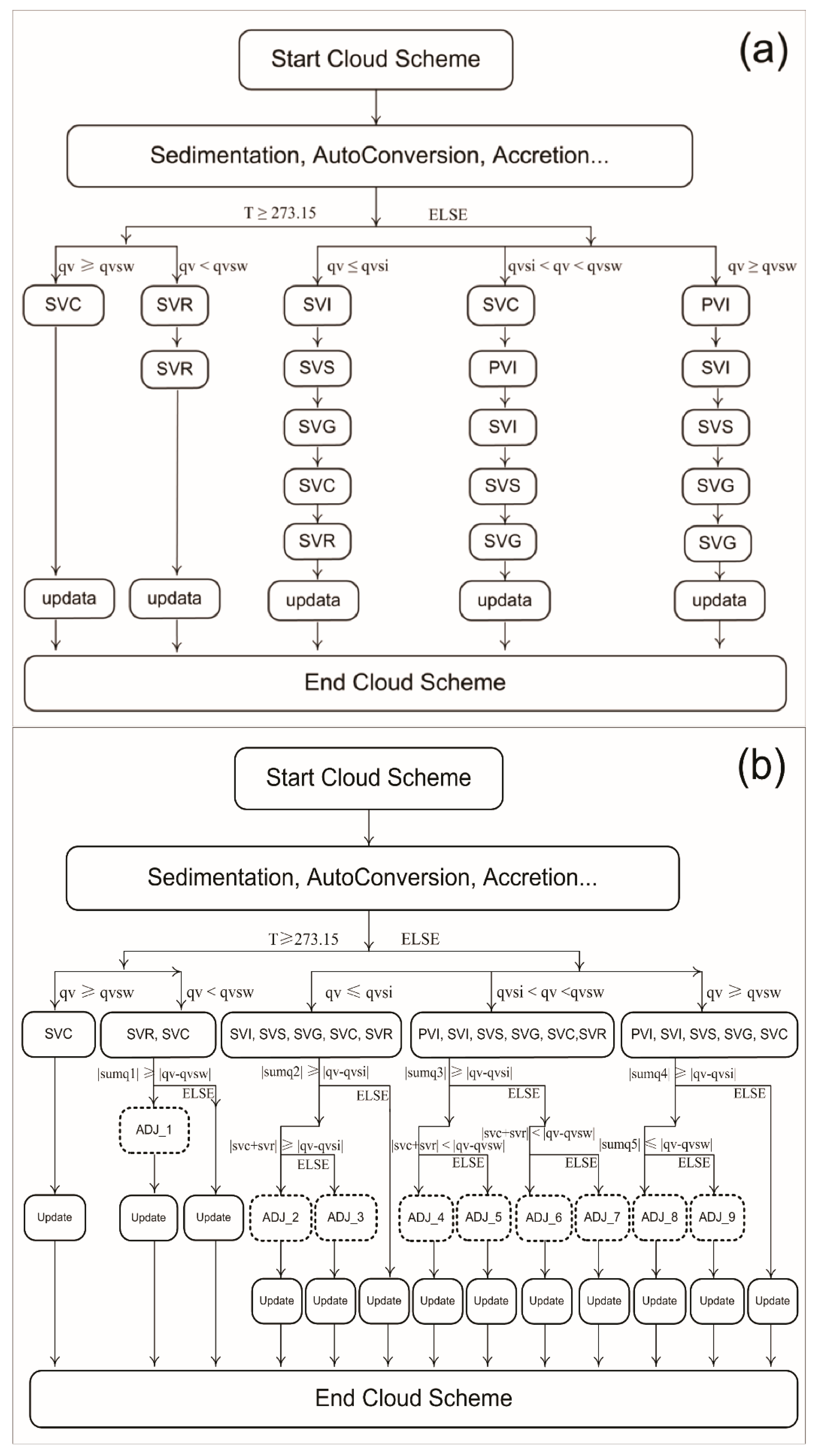

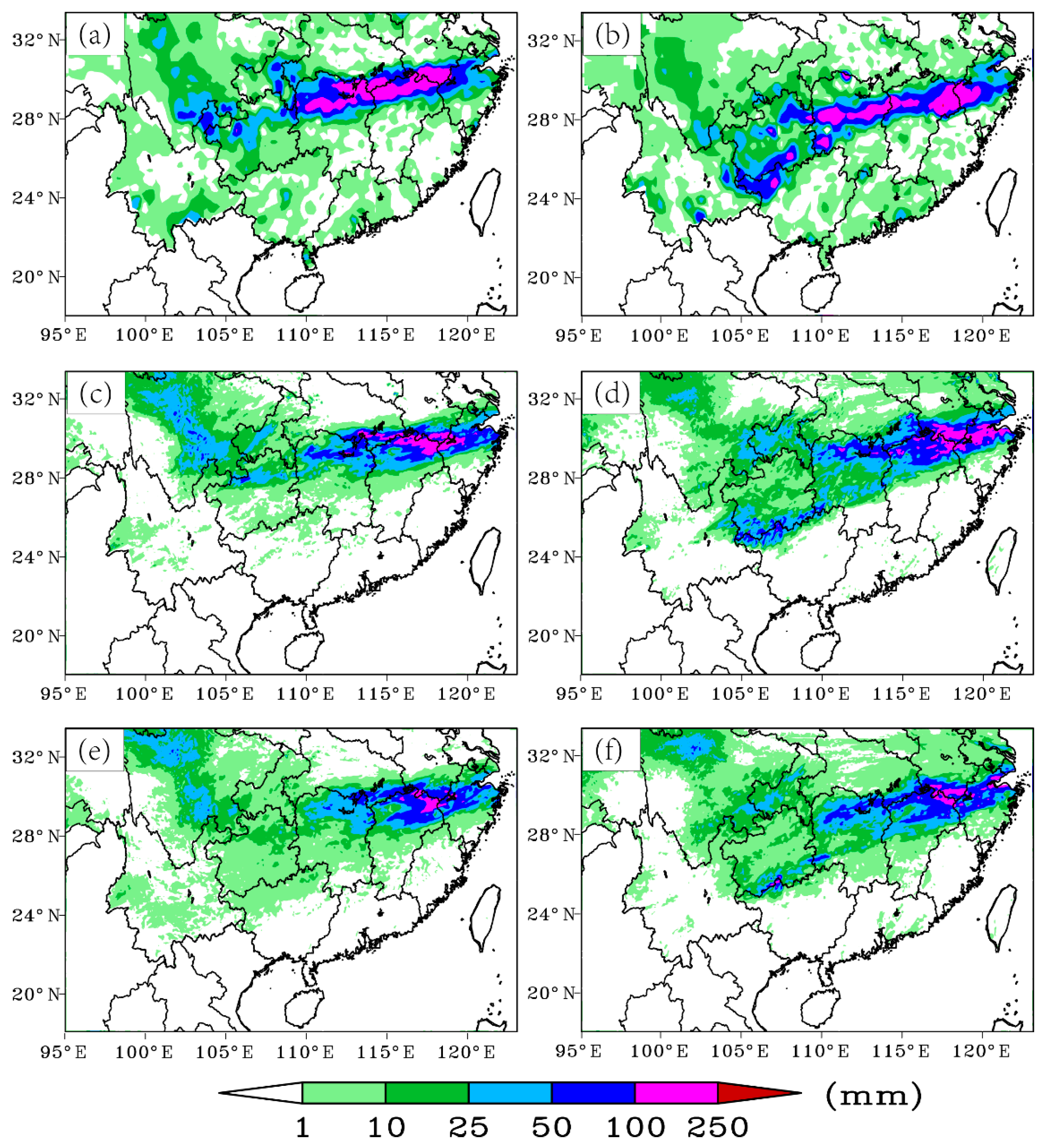
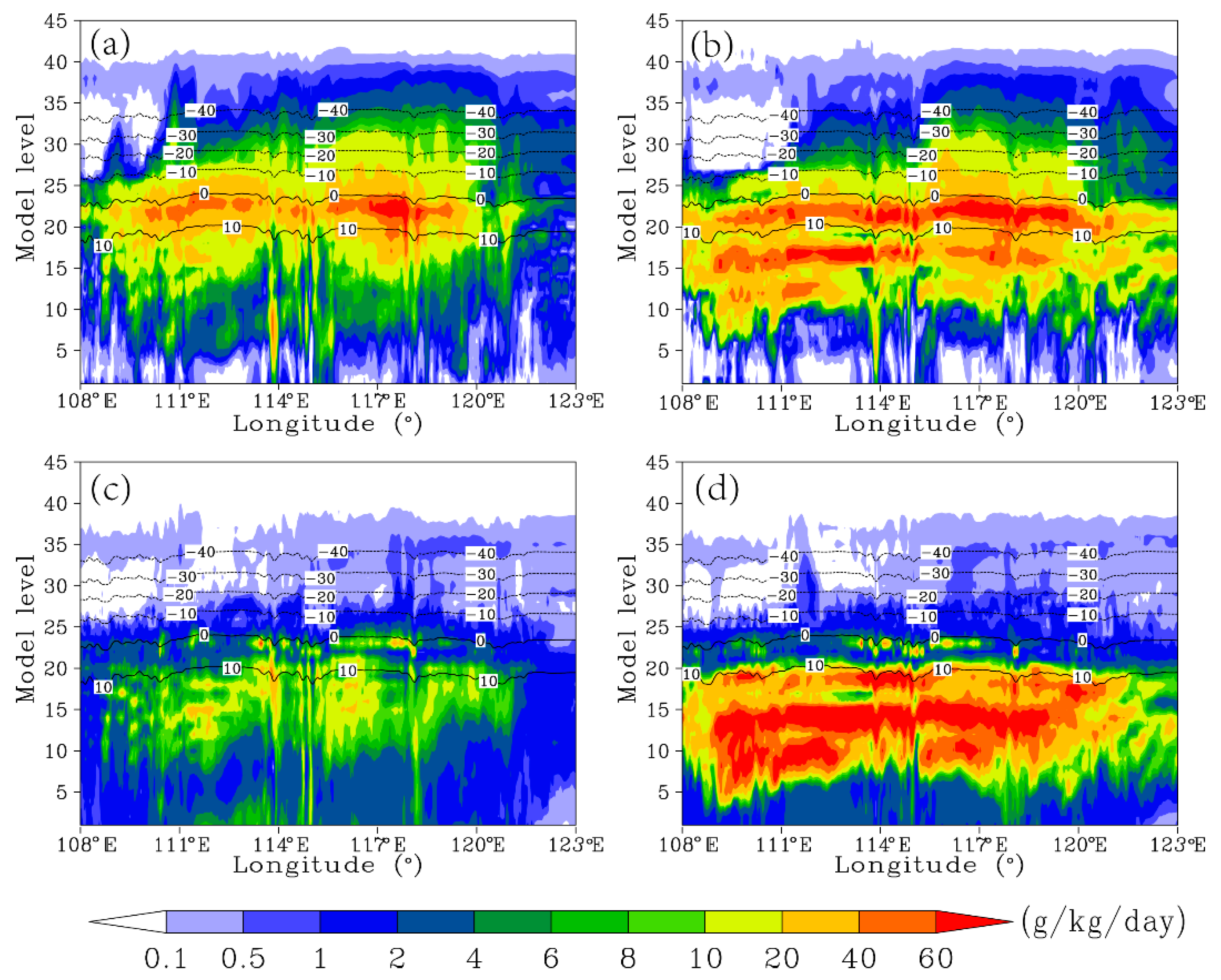
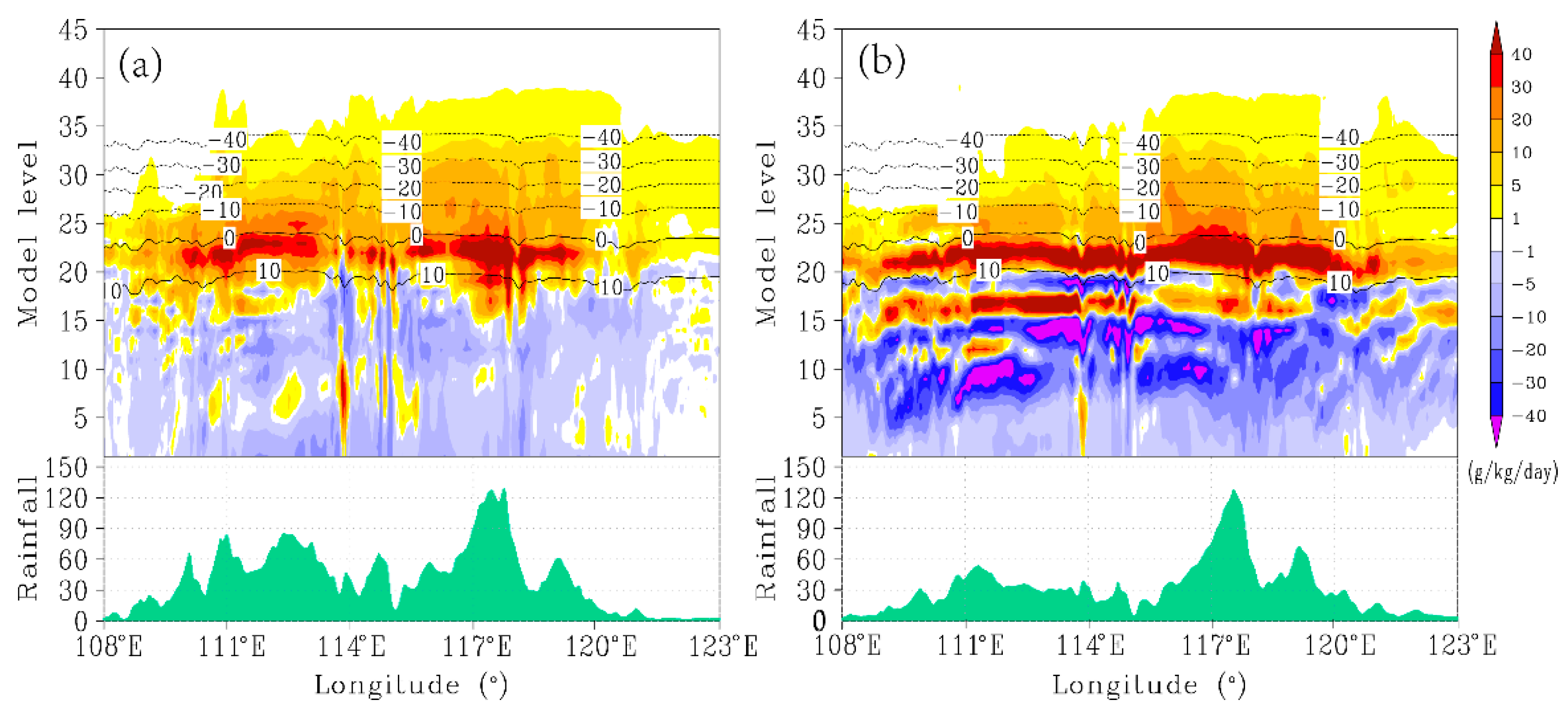

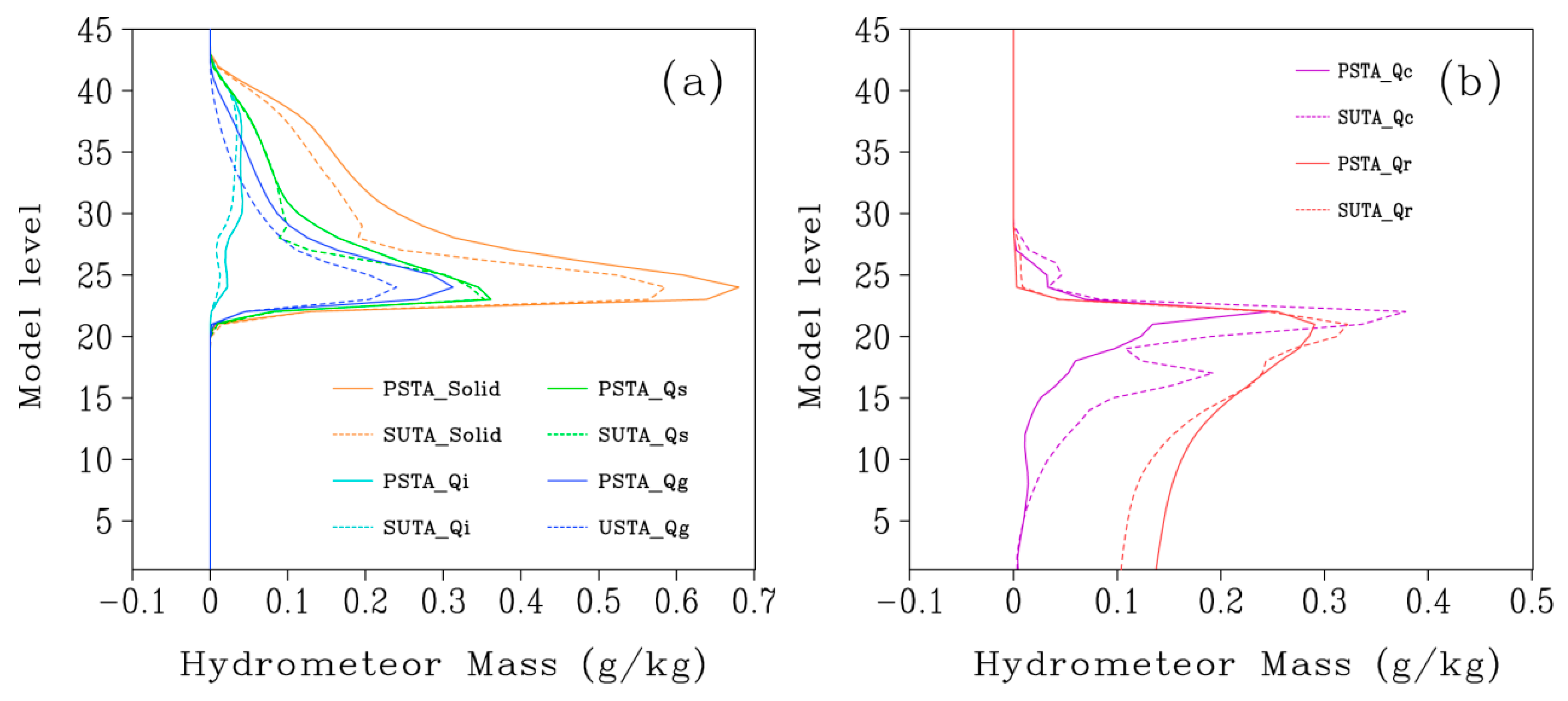

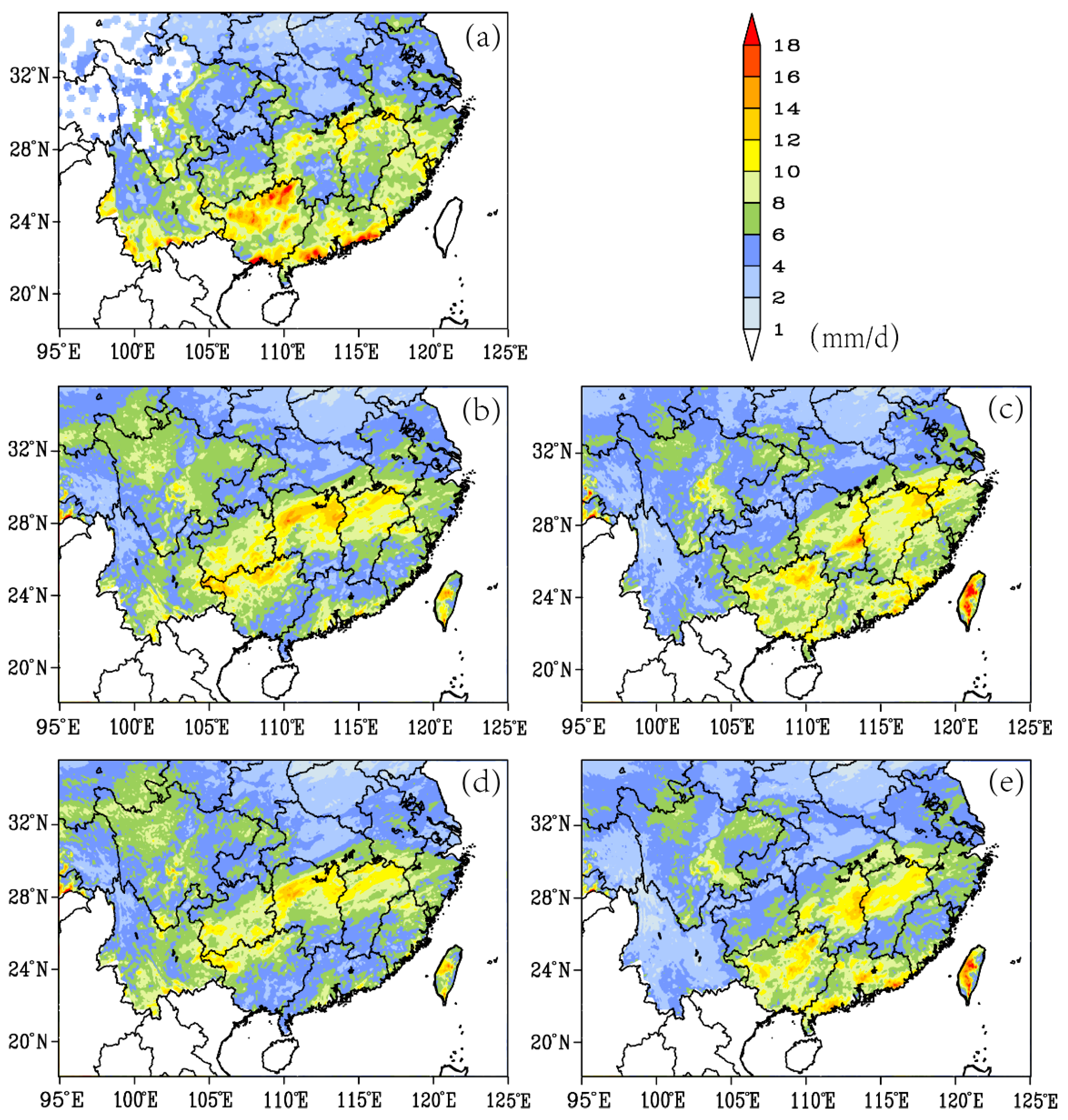
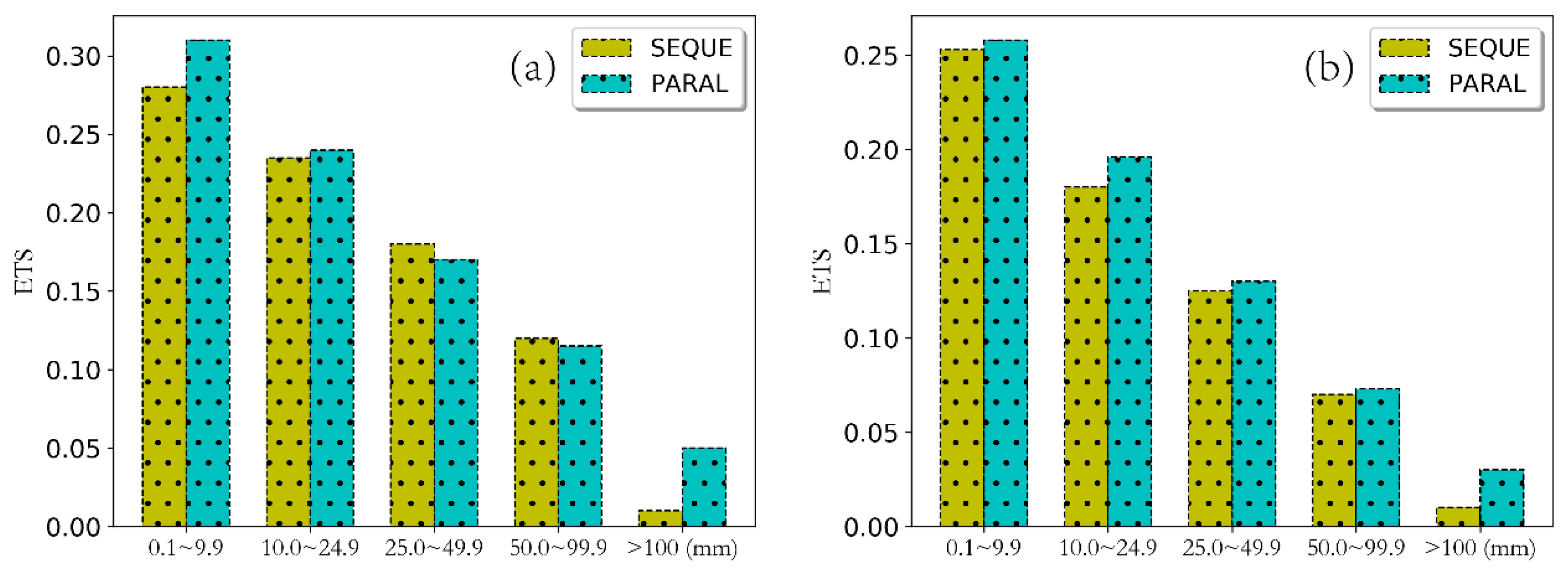
| Micophysics Variables | Cloud Droplet | Raindrop | Ice Crystal | Snow | Graupel |
|---|---|---|---|---|---|
| Particle Size Distribution | |||||
| Particle Mass | |||||
| Fall Speed | |||||
| Density | 1000 kg m−3 | 1000 kg m−3 | 380 kg m−3 | 100 kg m−3 | 400 kg m−3 |
Publisher’s Note: MDPI stays neutral with regard to jurisdictional claims in published maps and institutional affiliations. |
© 2022 by the authors. Licensee MDPI, Basel, Switzerland. This article is an open access article distributed under the terms and conditions of the Creative Commons Attribution (CC BY) license (https://creativecommons.org/licenses/by/4.0/).
Share and Cite
Ma, Z.; Liu, Q.; Zhao, C.; Li, Z.; Wu, X.; Chen, J.; Yu, F.; Sun, J.; Shen, X. Impacts of Transition Approach of Water Vapor-Related Microphysical Processes on Quantitative Precipitation Forecasting. Atmosphere 2022, 13, 1133. https://doi.org/10.3390/atmos13071133
Ma Z, Liu Q, Zhao C, Li Z, Wu X, Chen J, Yu F, Sun J, Shen X. Impacts of Transition Approach of Water Vapor-Related Microphysical Processes on Quantitative Precipitation Forecasting. Atmosphere. 2022; 13(7):1133. https://doi.org/10.3390/atmos13071133
Chicago/Turabian StyleMa, Zhanshan, Qijun Liu, Chuanfeng Zhao, Zhe Li, Xiaolin Wu, Jiong Chen, Fei Yu, Jian Sun, and Xueshun Shen. 2022. "Impacts of Transition Approach of Water Vapor-Related Microphysical Processes on Quantitative Precipitation Forecasting" Atmosphere 13, no. 7: 1133. https://doi.org/10.3390/atmos13071133







